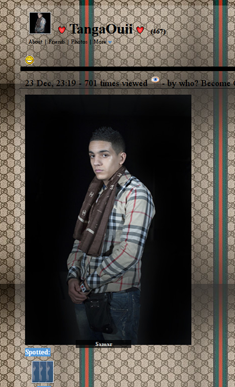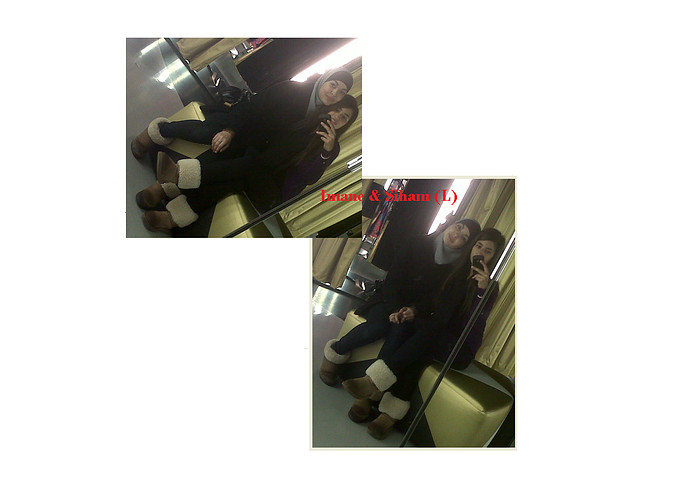I knew that going to call shops would be quite challenging and that the day-to-day reality of this experience would make it difficult to ignore the social issues and concentrate on the artefacts of digital folklore and low digital culture. At the same time, I secretly hoped that belhuizen would give me access to a different aspect of the internet – that places with names like Alhoceima, Amal, Agadir, Casablanca, Angada would open a door to the Arabic internet world for me. I was hoping to see websites and profiles made in the Arabic web design tradition which, I have heard, combines elements that have been floating around on the web since the Geocities days with a heavy application of glitter. I’ve heard that there are corporate websites out there that look like British singer M.I.A.’s videos[1] and that there are user profiles on social sites that surpass MySpace in its best years.
That’s why after receiving my access code ticket, I always tried to walk as slowly as possible into the farthest corner of the room so that I could see what kinds of sites other users were accessing on their computers. I was in for a disappointment, however because most of the clients in these call shops were hanging out on Western websites, primarily YouTube.
It wasn’t until two weeks later that I finally noticed a distinct trend in the social networking behaviour of Rotterdam’s internet café customers: they were not using Facebook, Twitter or MySpace; they were using Hyves.
Hyves is the number one social network in the Netherlands. It was created in 2004 and remains a dominant force in the Dutch web-user market despite the competition from its contemporary, Facebook, even though there has been a significant shift over the past year and a half. Statistics dating from 27 August 2011 list 11,492,171 Hyves members versus 4,759,520 Facebook users in the Netherlands[2]. In other words, there are twice as many Hyves members as Facebook members. Although, in the past, the difference was tenfold – this is the ratio cited by Marc de Vries, the CEO of Hyves, in his November 2010 interview with the Wall Street Journal about the sale of his company to the Telegraaf Media Groep. According to another article, Facebook had equalled Hyves in the number of active Dutch users in June 2011.[3]
Hyves statistics and data can be quite contradictory. For instance, Marc de Vries in the same interview characterises Hyves users as “All the youth in the Netherlands are on Hyves — approximately 85% of young people in the country use Hyves. Facebook in the Netherlands is for older users.”[4] Some Powerpoint presentations found online confirm this, but the Ignite Social Media agency cites very different figures. According to its research report, the Social Network Analysis Report, published in 2011[5], the majority of Hyves users, 65%, are 35 or over. Statistics about education levels show that the majority has at least a high school education. Income levels are average. But that data seems fairly meaningless since it’s basically the same as Facebook’s and the majority of other local and global social networks.
Journalists who write about social networks and bloggers who mention Hyves generally state that students and young professionals have abandoned Hyves. They feel it has become the domain of teens and the elderly. None of this is supported by current research data. Meanwhile students with BA or MA degrees I spoke to in Rotterdam have a similar impression. They are certain that Hyves has grown outdated.
My surfing experience suggests that Hyves is especially popular among teenagers with an immigrant background. Statistics on social media use by ethnic groups are unavailable, and indirect findings do not support my theory. For instance, the number of Hyves members from ethnic communities remains very small. Of them, only the Surinamese community made the popular list, but is only ranked at #240. Communities dedicated to Chanel and Birkenstocks have far more members than the Gucсi community and Gucci is the most popular brand among African-Dutch teenagers.
I will not claim that Facebook is the network for the educated Dutch native population, while Hyves is preferred by immigrant youth, similar to what Danah Boyd attempted in 2007, when she divided Facebook and Myspace users into upper class and working class, respectively.[6] But still, I couldn’t help noticing that cafés with WiFi access were mostly frequented by Facebook users while belhuis clients prefer Hyves.
So I didn’t manage to find my way inside the Arabic/African vernacular web. However I did manage to find out more about Hyves and that can be classified as a trip back in time.
Hyves is old-fashioned or, more accurately, it encourages its users to create profiles that follow the design traditions of web hosting services from the 90s.
In the terms of the new millennium, Hyves is one of those social networks that encourages you to “pimp your profile,” meaning that it allows a user to choose his or her own wallpaper, different colours for various navigation elements, and the arrangement of objects on the page.
“Pimp My Profile” is an option that can be regarded from various, even diametrically opposed, viewpoints. On the one hand, it is a notorious “sandbox” for users to be busy with unimportant details like choosing the colours for the table borders or the position of one’s background picture. On the other hand – social networks that push the offer to personalize profiles follow and keep the primordial web tradition of constructing personal pages from modules.
As recently as a few years ago, this option was being offered by virtually every major platform with the exception of Facebook, which took the decision on how profile pages and user walls should look away from its users. It also limits the types of graphics formats one can share, above all banning animated GIFs in order to appear calmer, cleaner and to distance itself from the strong and old web amateur tradition to make animated GIFs and to use them.
When Facebook became the major social networking site, other sites – including Facebook’s antipode, MySpace – began reconsidering their own policies. In fact, it was only until very recently that MySpace allowed its users to edit the source code of their personal pages and use animated GIFs. The user was free to create a visual cacophony of the worst possible kind if he or she so desired. But in October 2010, MySpace announced a complete site redesign. The “Customize” button is still there, as prominent as ever, and still offers a wide variety of layouts and themes, but all of them look exceptionally clean and tidy in a young yet mainstream kind of way. Another social networking site, Hi5, limits you to choosing a site skin; the same is true for Livejournal. Friendster, after the site’s redesign and change of direction in June 2011, no longer allows users to do anything except exchange games.
Like Facebook, Google+, the network that was launched in July 2011 to dominate the market for “identity services with social networking aspects”, limits you to editing your profile with no “pimping” options. It’s interesting, however, that Google+ has reintroduced animated GIFs – which can either be seen as a gesture of respect for this genuinely web-specific format or simply to spite Facebook. And even though you can’t use GIFs for your background or your user picture, the mere presence of them on your network update page brings the service closer to people.
It’s strange that Hyves, with all its many colours and layout options, does not support graphics in GIF format, even for its paid users. Although, for a monthly fee of €4.95, you can choose from more animated elements on your profile including a “userpic” that resembles a slide show, floating speech bubbles, and a large selection of smileys. However, I think the main reason users pay for a Gold membership is that it allows them to spy on their visitors and see who has checked out their profiles. Although, when there’s the possibility of using 40 kinds of smileys instead of the standard 15, the temptation to upgrade increases proportionally. Needless to say, paid user profiles on Hyves are totally “dynamic”.
But even free users have a big enough variety of options that allows them to tinker with their pages to their heart’s content. The “Edit Profile” link leads to the “Design Profile” page where you can choose a theme from the site’s collection – for instance, “Aqua”, “Winter” or “Pretty in Pink”. Next, you decide whether you want to keep the default background image or use your own. The default pink background from “Pretty in Pink” is very popular with many users keeping it, unlike the majority of other backgrounds, which are often quickly replaced by custom graphics.



The next step: Should we leave the content boxes semi-transparent, make them totally transparent or totally opaque? What about text colour? There are an infinite number of possibilities here. You can also choose the colour of your links and active links and, last but not least, the width and colour of your borders. You can even have a drop shadow.
Now, who could ever refuse a drop shadow? The same goes for the other template corrections, especially since the page builder allows you to preview your changes on the fly. No one can resist the temptation, and that’s why, among professional web designers, Hyves profiles are considered notorious examples of what the web looks in the hands of amateurs.
Yet, it must be said that Hyves’ developers, took good care of the site’s usability aspects by letting end users view other users profiles in “normal design” or “personal design” and letting them easily switch from the one mode to the other. “Normal design” ignores all the customisations and implies a reduced palette closer to the Facebook aesthetic with clean thin lines and minimal clutter. Only the blinking smileys hint at the underlying visual noise.
“Normal design” definitely makes it more comfortable to read status updates, but you can’t see background images in this mode. And in my opinion, the background images are the information-richest parts of a user’s profile. The way Hyves’ users employ images is the most interesting aspect of this social network.
The customisation tool allows users to substitute the default background image with a custom one but also allows them to choose how they apply it: by tiling the image or stretching it, for example. A user may decide to use an image as a border element by setting up a single row of image repeats on the top or bottom of the page or turn repeating off completely.
This option is not unique; other big players like Twitter and YouTube, also offer a “tile or stretch” option. The stretch option is most useful in cases when a single image is big enough to serve as wallpaper without the need for tiling or repeating it. But its important to make sure that it doesn’t begin repeating on larger monitors with larger resolutions.
It’s interesting to observe how enthusiastic Hyves users are about this option, how often they choose background images or photos only to decide not to make wallpaper out of it. Instead, they often opt to leave the image in the centre of the page or in the upper left or right corner and often avoid using the “tile” option. Like this, the image becomes a statement that compliments their userpic: Here’s my userpic, and here in the background you can see my car, my boyfriend, my favourite clothing brand, my idol, my native country – or my money! A stack of paper money is one of the most popular subjects for background images.[7]
Users often employ their background images in contrast to their user pictures as opposed to using it to compliment one’s userpic. Thus a userpic of a tough-looking thug is contrasted with a background image of the same guy warmly smiling in a family photo. Or, a girl who looks extremely promiscuous in her userpic but uses a background photo showing her tenderly holding a baby. At first, these combinations may seem like weird coincidences, but when you see them over and over again, you begin to understand that their contradictory nature expresses a certain message: Everybody thinks that I am X, when in fact, I am Y; or I’m not just X, I’m also Y.

These look especially revealing when the rest of a user’s content is hidden, and all you get to see is the background and userpic, which is the case with private profiles that are only accessible to friends. These portraits become a unique message to humankind, an outpour of emotions. They can also be humorous or sarcastic like the pairing of a userpic of a young man dressed in Chanel, Burberry and Dolce & Gabana on a background of – this time – tiled Gucci logos.
Often, the background serves as a type of photo album. The user accomplishes this by choosing several smaller photos and using graphic editing software to compile them into a collage that can later be used as a background image. This process goes against the logic of a tiled background, but users get what they want: a display of all of the desired pictures at once by circumventing the standard “create a photo album” feature.
Conversely, users sometimes take a small pattern file that serves as the default background and use it for their userpic. Here, once again, the popularity of the “Pretty in Pink” theme is second to none.
Since version 1.1 of the Netscape browser was launched in early 1995, users have made pages using backgrounds. They became an essential element for online self-expression and self-promotion. Backgrounds are a big, as-yet-unwritten chapter in the history of Digital Folklore. Web users learned to make their own backgrounds and used them to communicate with. Hyves users are the masters of this type of communication.
Of course, it’s not always like that. I may be exaggerating or over-interpreting some things, consciously ignoring profiles that are a load of trash, a meaningless pile of images downloaded from someone’s phone or taken from someone else’s profiles, because I don’t think this is what makes Hyves unique and memorable. I am still constantly amazed by the ability of Hyves and other social media users to think beyond the software’s limitations and so effortlessly prove that what keeps the Web alive are its users and not necessarily its developers.
But before it is shut down, will the company give its users time to save their files – and will they bother to do so?
In the meantime, I take the courage to bring some of Hyves’ classic motifs to the foreground.





